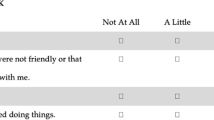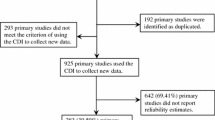Abstract
Objectives
To examine the psychometric properties and test the theoretical quality of the German version of the Centre for Epidemiological Studies depression scale for children (CES-DC), a 20-item screening instrument measuring the frequency of parent- and self-reported depressive symptoms in children and adolescents.
Methods
Using a population-based, representative sample of n = 2,863 7 to 17-year-old German children and adolescents, factorial validity were determined by means of linear structural equation modelling. Cross-sectional coefficients of reliability, inter-rater agreement as well as descriptive statistics of the scales were calculated.
Results
In a population-based German sample, the four-factor version of the CES-DC following Radloff (Appl Psychol Meas 1:385–401, 1977) is considered to have good factorial validity and stability across age and informant versions. The main problems of the questionnaire are the high item difficulties, strong floor effects of the scales and low cross-sectional reliability, which are acceptable only for screening purposes. The low inter-rater agreement indicates that parental assessment can replace self-assessment only to a limited degree.
Conclusion
The strengths and weaknesses of the CES-DC are discussed taking previous data and comparable tests into consideration. Particular advantages are the existence of the parent-report form and the adult version, as well as its multifactorial structure. Parental assessment should be supplemented by self-report data whenever possible.
Similar content being viewed by others
References
Achenbach T (1979) The child behavior profile: an empirically based system for assessing children’s behavioral problems and competencies. Int J Ment Health 7:24–42
Aguilar G, Berganza CE (1990) Validacion del CES-DC-M. Para el Diagnostico de la Depresion en Adolescentes Guatemaltecos. Av Piscol Clin Latinonot 8:75–84
Aguilar G, Berganza CE (1993) Confiabilidad test-retest de la Escala de Depresion para Ninos y Adolescentes del Centro de Estudios Epidemiologicos (CES-DC-M), en el diagnostico de la depresion en adolescentes guatemaltecos. Av Piscol Clin Latinonot 11:59–63
Beaton D, Bombardier C, Guillemin F, Bosi Ferraz MB (2002) Recommendations for the cross-cultural adaptation of health status measures. Institute for Work and Health, Illinois
Beck AT, Ward C, Mendelson M (1961) Beck depression inventory (BDI). Arch Gen Psychiatry 4:561–571
Berganza CE, Aguilar G (1992) Depression in Guatemalan adolescents. Adolescence 27:771–782
Birmaher B, Ryan ND, Williamson DE, Brent DA, Kaufman J, Dahl RE, Perel J, Nelson B (1996) Childhood and adolescent depression: a review of the past 10 years. Part I. J Am Acad Child Adolesc Psychiatry 35:1427–1439
Cohen J (1988) Statistical power analysis for the behavioral sciences. Erlbaum, Hillsdale
Costello EJ, Angold A (1988) Scales to assess child and adolescent depression: checklists, screens and nets. J Am Acad Child Adolesc Psychiatry 27:726–737
Dillon RD, Kumar A, Mulani N (1987) Offending estimates in covariance structure analysis: comments on the causes of and solutions to Heywood cases. Psychol Bull 101:126–135
Doerfler LA, Felner RD, Rowlison RT, Raley PA, Evans E (1988) Depression in children and adolescents: a comparative analysis of the utility and construct validity of two assessment measures. J Consult Clin Psychol 56:769–772
Faulstich ME, Carey MP, Ruggiero L, Enyart P, Gresham F (1986) Assessment of depression in childhood and adolescence: an evaluation of the Center for Epidemiological Studies depression scale for children (CES-DC). Am J Psychiatry 143:1024–1027
Fendrich M, Weissman MM, Warner V (1990) Screening for depressive disorder in children and adolescents: validating the Center for Epidemiologic Studies depression scale for children. Am J Epidemiol 131:538–551
Finkbeiner C (1979) Estimation for the multiple factor models when data are missing. Psychometrika 44:409–420
Harrington R, Clark A (1998) Prevention and early intervention for depression in adolescence and early adult life. Eur Arch Psychiatry Clin Neurosci 248:32–45
Jöreskog KG, Sörbom D (1996) Prelis2: user’s reference guide. Scientific Software International, Lincolnwood
Jöreskog KG (1999) How large can a standardized coefficient be? http://www.ssicentral.com/lisrel/techdocs/ HowLargeCanaStandardizedCoefficient be.pdf. Accessed 22 June 1999
Kovacs M (1992) The children’s depression inventory (CDI) manual. Multi-Health Systems, New York
Kurth BM, Bergmann KE, Hölling H, Kahl H, Kamtsiuris P, Thefeld W (2002) Der bundesweite Kinder- und Jugendgesundheitssurvey. Das Gesamtkonzept. Gesundheitswesen 64: S3–S11
Lang M, Tisher M (1987) Childrens depression scale manual, North American Edition. Consulting Psychologists Press, Palo Alto
McCall WA (1939) Measurement. Macmillan, New York
Myers K, Winters N (2002) Ten-year review of rating scales. II: scales for internalizing disorders. J Am Acad Child Adolesc Psychiatry 41:634–659
Olsson G, von Knorring AL (1997) Depression among Swedish adolescents measured by the self-rating scale Center for Epidemiology Studies-depression child (CES-DC). Eur Child Adolesc Psychiatry 6:81–87
Radloff LS (1977) The CES-D scale: a self-report depression scale for research in the general population. Appl Psychol Meas 1:385–401
Ravens-Sieberer U, Kurth B-M, KiGGS study group, BELLA study group (2008) The mental health module (BELLA study) within the German Health Interview and Examination Survey of Children and Adolescents (KiGGS): study design and methods. Eur Child Adolesc Psychiatry 17(Suppl 1):10–21
Rossmann P (2005) Depressionstest für Kinder (DTK). Hans Huber Verlag, Bern
Schermelleh-Engel K, Moosbrugger H (2003) Evaluating the fit of structural equation models: Tests of significance and descriptive goodness-of-fit measures. Methods Psychol Res Online 8:23–74
Schoenbach VJ, Kaplan BH, Wagner EH, Grimson RC, Miller FT (1983) Prevalence of self-reported depressive symptoms in young adolescents. Am J Public Health 73:1281–1287
Shafer AB (2006) Meta-analysis of the factor structures of four depression questionnaires: Beck, CES-D, Hamilton and Zung. J Clin Psychol 62:123–146
Sharp LK, Lipsky MS (2002) Screening for depression across the lifespan: a review of measures for use in primary care settings. Am Fam Physician 66:1001–1008
Stiensmeier-Pelster J, Schürmann M, Duda K (2000) Depressions-Inventar für Kinder und Jugendliche (DIKJ), Handanweisung. Hogrefe, Göttingen
Weissman MM, Orvaschel H, Padian N (1980) Children’s symptom and social functioning self-report scales: comparison of mothers’ and children’s reports. J Nerv Men Dis 168:736–740
West SG, Fich JF, Curran PJ (1995) Structural equation models with nonnormal variables: problems and remedies. In: Hoyle RH (ed) Structural equation modeling: concepts, issues, and applications. Sage, Thousand Oaks, pp 56–75
Conflict of interest
All authors declare no conflict of interest.
Author information
Authors and Affiliations
Consortia
Corresponding author
Additional information
Members of the BELLA Study Group: Ulrike Ravens-Sieberer (Principal Investigator), Claus Barkmann, Susanne Bettge, Monika Bullinger, Manfred Döpfner, Michael Erhart, Beate Herpertz-Dahlmann, Heike Hölling, Franz Resch, Aribert Rothenberger, Michael Schulte-Markwort, Nora Wille, Hans-Ulrich Wittchen.
Rights and permissions
About this article
Cite this article
Barkmann, C., Erhart, M., Schulte-Markwort, M. et al. The German version of the Centre for Epidemiological Studies Depression Scale for Children: psychometric evaluation in a population-based survey of 7 to 17 years old children and adolescents – results of the BELLA study. Eur Child Adolesc Psychiatry 17 (Suppl 1), 116–124 (2008). https://doi.org/10.1007/s00787-008-1013-0
Published:
Issue Date:
DOI: https://doi.org/10.1007/s00787-008-1013-0




